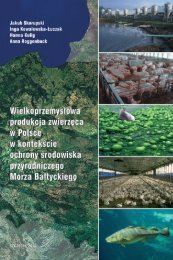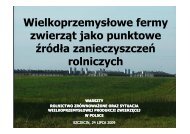best available technologies for manure treatment - Baltic Green Belt
best available technologies for manure treatment - Baltic Green Belt
best available technologies for manure treatment - Baltic Green Belt
You also want an ePaper? Increase the reach of your titles
YUMPU automatically turns print PDFs into web optimized ePapers that Google loves.
Best Available Technologies <strong>for</strong> <strong>manure</strong> <strong>treatment</strong> baltic sea 2020<br />
Best Available Technologies <strong>for</strong> <strong>manure</strong> <strong>treatment</strong> baltic sea 2020<br />
ANNEX E: TABLES WITH SHORT DESPRIPTION OF LIVESTOCK MANURE TREATMENT TECHNOLOGIES<br />
Best Available Techniques <strong>for</strong> <strong>manure</strong> <strong>treatment</strong> - <strong>for</strong> intensive rearing of pigs in <strong>Baltic</strong> Sea Region EU Member States Technical Report "Best Practice Manure Handling, Phase 2"<br />
conditions.<br />
3. Additives <strong>for</strong> changing the physical properties of the <strong>manure</strong>: The objective of the additive is to make<br />
the <strong>manure</strong> easier to handle. These additives are probably the most used and their effects are well<br />
known. Their use results in an increase in <strong>manure</strong> flowing, an elimination of superficial crusts, a<br />
reduction of solved and suspended solids and a reduction in the stratification of the <strong>manure</strong>. However,<br />
these effects were not demonstrated in every comparable case.<br />
Their application might make the cleaning of the <strong>manure</strong> pits easier, and thereby might shorten the<br />
cleaning time required and allow a saving in water and energy consumption. Moreover, since the <strong>manure</strong><br />
is more homogeneous, it eases the <strong>manure</strong>’s agricultural use (better dosing).<br />
4. Additives <strong>for</strong> increasing the fertilising value of the <strong>manure</strong>: This effect is in fact derived from the<br />
reduction in NH<br />
3<br />
emissions, thereby keeping this N retained in the <strong>manure</strong> (in many cases through the<br />
increased synthesis of the microbial cells, giving higher levels of organic N).<br />
5. Additives <strong>for</strong> stabilising pathogens micro-organisms: There are many different microorganisms in<br />
<strong>manure</strong>, part of these contribute to the gaseous emissions and odours. It is also possible to find faecal<br />
coli <strong>for</strong>ms and Salmonella and other pig pathogens, virus, eggs of flies and nematodes in the <strong>manure</strong>.<br />
Usually, the longer the storage period the higher the decrease in pathogens, because of the different<br />
requirements of temperature and pH. The pH decreases within the first month of storage (from 7.5 to<br />
6.5 because the microbial synthesis of volatile fatty acids) which has a negative effect on pathogens<br />
survival. Some of the <strong>manure</strong> additives have been designed to control them, especially the eggs of flies.<br />
Types of <strong>manure</strong> additives<br />
masking and neutralising agents: These are a mix of aromatic compounds (heliotropin, vanillin)<br />
that work by masking the <strong>manure</strong> odour. The agent is easily destroyed by <strong>manure</strong> microorganisms.<br />
Its actual efficacy is questionable.<br />
adsorbers: There are a large number of substances that have demonstrated an ability to adsorb<br />
ammonia. Some types of zeolites called clinoptilolites have shown the <strong>best</strong> effect, being added<br />
either to the <strong>manure</strong> or to feed on ammonia emission. They are also able to improve soil structure<br />
and have the added benefit that they are not toxic or hazardous. Peat gives similar results and is<br />
also sometimes used.<br />
urease inhibitors: These compounds stop the reaction described earlier preventing urea from being<br />
trans<strong>for</strong>med into ammonia. There are three main types of urease inhibitor:<br />
1. phosphoramides: applied directly to the soil. Show a good effect. They work better in acid<br />
soils, but could affect soil micro-organisms<br />
2. yucca extracts (Y. schidigera): many trials have been done to assess its potential but the<br />
<strong>available</strong> in<strong>for</strong>mation is controversial, showing good results in some cases, but no effect<br />
60<br />
Page 61<br />
60








